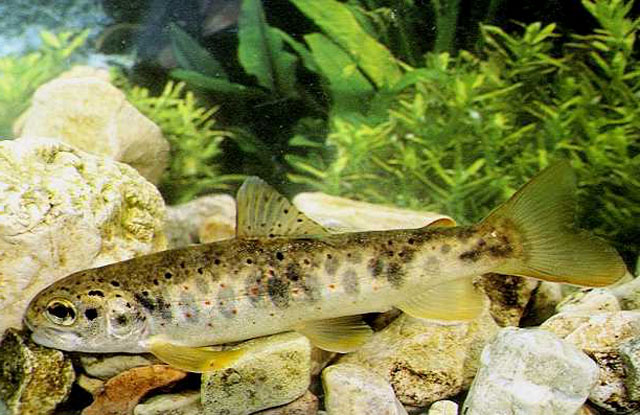| Salmonidae (Salmonids), subfamily: Salmoninae |
| 140 cm SL (male/unsexed); max.weight: 50 kg; max. reported age: 38 years |
|
pelagic-neritic; freshwater; brackish; marine; depth range 0 - 28 m, anadromous |
| Europe and Asia: Atlantic, North, White and Baltic Sea basins, from Spain to Chosha Bay (Russia). Found in Iceland and northernmost rivers of Great Britain and Scandinavia. In Rhône drainage, native only to Lake Geneva basin, which it entered after last glaciation. Native to upper Danube and Volga drainages. Introduced widely. Several countries report adverse ecological impact after introduction. |
|
Dorsal spines (total): 3-4; Dorsal soft rays (total): 10-15; Anal spines: 3-4; Anal soft rays: 9-14; Vertebrae: 57-59. Fusiform body (Ref. 51442). Head little and pointed (Ref. 51442). Mouth large, extending mostly after the eye and has well developed teeth (Ref. 51442). Teeth on shaft of vomer numerous and strongly developed (Ref. 7251). Caudal fin with 18-19 rays (Ref. 2196). Caudal peduncle thick and rounded (Ref. 51442). Little scales (Ref. 51442). Body is grey-blue colored with numerous spots, also below the lateral line (Ref. 51442). Blackish colored on upper part of body, usually orange on sides, surrounded by pale halos. Adipose fin with red margin. |
| Found in streams, ponds, rivers and lakes (Ref. 5951). Individuals spend 1 to 5 years in fresh water and 6 months to 5 years in salt water (Ref. 51442). Juveniles mature in 3-4 years (Ref. 6885). Lacustrine populations undertake migration to tributaries and lake outlets to spawn, rarely spawning on stone, wave-washed lake shores. Spawns in rivers and streams with swift current, usually characterized by downward movement of water intro gravel (Ref. 59043). Spawning takes place normally more than one time (Ref. 51442). They prefer cold, well-oxygenated upland waters although their tolerance limits are lower than those of rainbow trout and favors large streams in the mountainous areas with adequate cover in the form of submerged rocks, undercut banks, and overhanging vegetation (Ref. 6465). Life history and spawning behavior is similar to the salmon Salmo salar (Ref. 51442). Each female produces about 10.000 eggs (Ref. 35388, Ref. 51442). Mainly diurnal (Ref. 682). Sea and lake trouts forage in pelagic and littoral habitats, while sea trouts mainly close to coast, not very far from estuary of natal river (Ref. 59043). Juveniles feed mainly on aquatic and terrestrial insects; adults on mollusks, crustaceans and small fish (Ref. 26523, Ref. 51442). Marketed fresh and smoked; eaten fried, broiled, boiled, cooked in microwave, and baked (Ref. 9988). |
|
Least Concern (LC); Date assessed: 05 March 2010 Ref. (130435)
|
| potential pest |
|
Introduced to New South Wales, Victoria, Tasmania, South Australia and Western Australia (Ref. 7300). The first successful introduction of trout into Australia occurred in 1864 when brown trout ova were brought to Tasmania from England. A breeding program commenced and by 1872 eggs and fry raised in Tasmania were being sent to New South Wales, Victoria, and New Zealand (Ref. 26522).
Trout were introduced to Australian inland waters, primarily for their sporting value. They are cool-water (4°-19° C) species, restricted mainly to alpine and sub-alpine waters. Self maintaining populations of brown trout occur in higher altitude waters of New South Wales, Victoria and Tasmania. Populations are maintained by stocking in warmer rivers and reservoirs throughout New South Wales and Victoria. Cooler waters in Tasmania mean that trout are common down to sea level Ref 26519). Trout populations are also present in rivers and reservoirs around Adelaide in South Australia and in the southwest of Western Australia. Populations in Western Australia are largely maintained by continued stocking as there is an absence of suitable natural spawning sites. There are also isolated populations of sea run trout in Tasmanian and Victorian streams.
More than one variety of brown trout has been introduced to Australia, and their genetic status is unclear. Hence, there might be more than one stock present in Australian waters.
Commercial fishery: There is no commercial fishery for wild stocks of trout in Australian waters.
Aquaculture: Brown trout are not cultured commercially in Australia, although fry and fingerlings are produced by hatcheries for stocking.
Recreational fishery: Trout were introduced to Australia for their sporting qualities. They have been released into rivers, lakes and impoundments throughout southern Australia. Many populations are self reproducing but others are maintained in marginal waters by continued stocking (eg many Western Australian rivers). The rivers and lakes of alpine and sub-alpine areas of New South Wales, Victoria and Tasmania are the major centres for recreational trout fishing.
Trout are taken primarily on rod-and-line using bait, lures or flies. The method used varies, depending on the angler and the waters. Brown trout species are considered excellent angling fish, with larger adults being targeted. The Australian Anglers Association record for brown trout is 12,700 g from Tasmania, but larger fish have been unofficially recorded.
Resource status: Brown trout have established breeding populations in many rivers, lakes and impoundments in Australia. Stocking of waterways is carried out by many State fisheries agencies. Freshwater angling is a major recreational industry, and trout are the species most sought after. The major threats to trout fisheries come from habitat loss and degradation through pollution, siltation, and water extraction.
Notes: The success of trout in Australian waters is largely attributable to the similarity of Australian and ancestral habitats, and the absence of large, coldwater predatory native fish (Ref. 26529). However, trout are thought to have displaced native trout (Galaxias species) from many waters (Ref. 26536).
Movement and home range studies of brown trout in Aberfeldy River, Victoria suggest that 1+ and older trout move about 60 m of river and that of 0+ fish range over 370 m (Ref. 26880). Brown trout migrations also occur in Liawenee Canal, Great Lake in Tasmania (Ref. 26524).
Also Ref. 1739. |
Source and more info: www.fishbase.org. For personal, classroom, and other internal use only. Not for publication.

